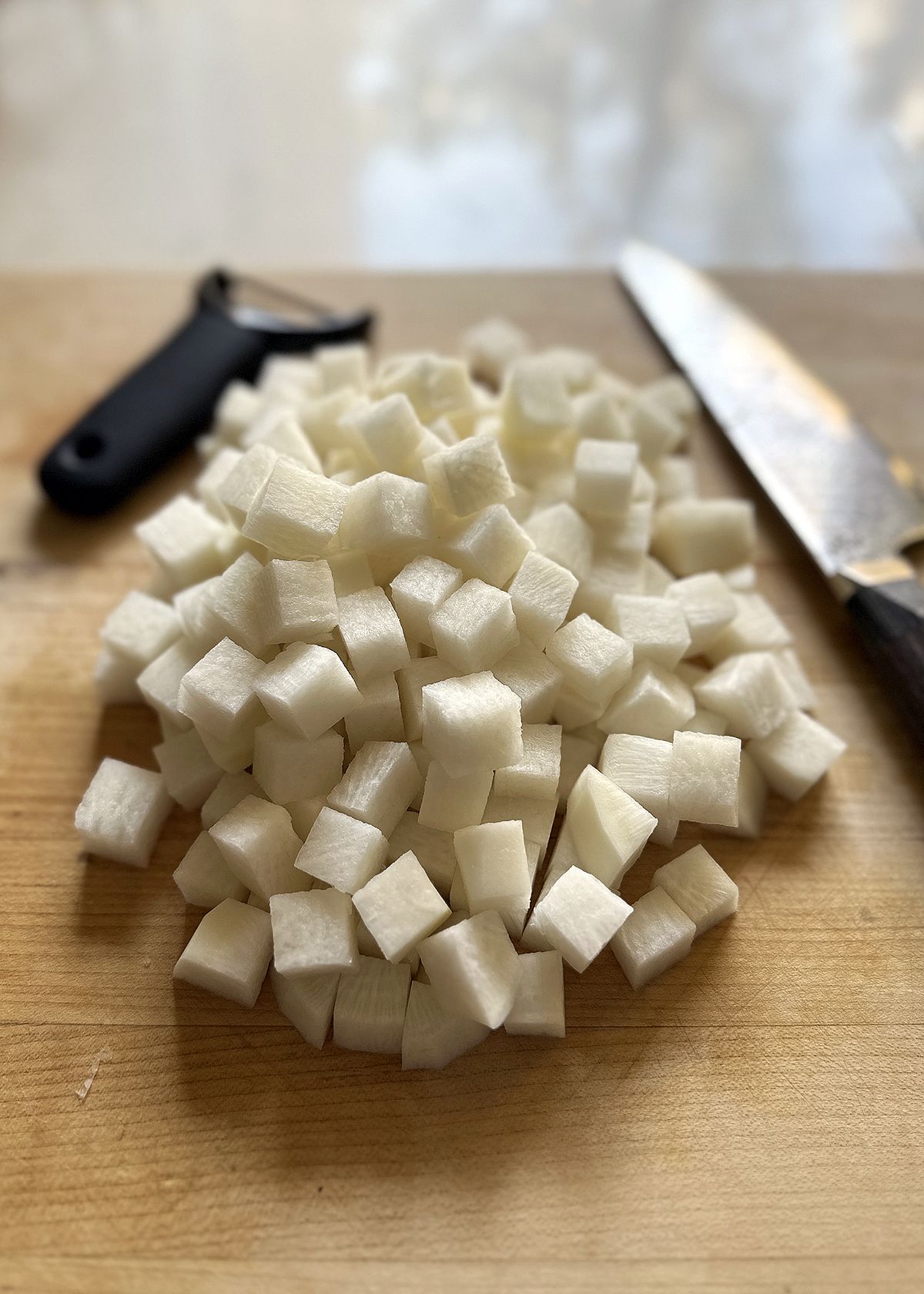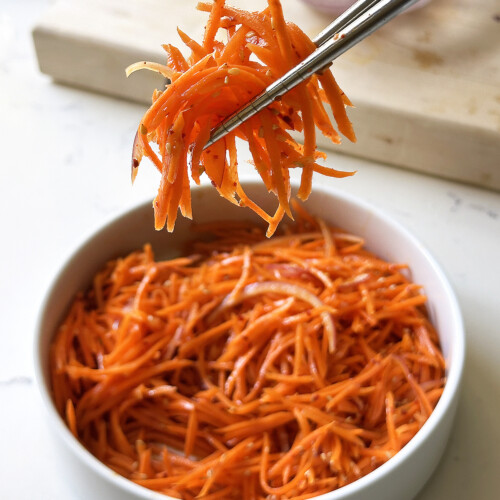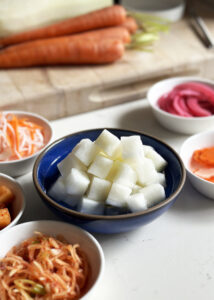Korean Radish Kimchi or "Kkakdugi" for the real ones, has only a few ingredients, is super easy to make, and tastes so perfectly deliciously customized to your preferences, you'll never be able to buy those crispy crunchy spicy cubes from somewhere else again. Shall we?

Jump to:
- So What is Korean Radish Kimchi aka Kkakdugi?
- Kkakdugi vs Mu-Saeng-chae vs Chicken Mu vs Mu Namul...Korean Radish Banchans
- Is Korean Radish Kimchi Healthy?
- What Ingredients You Need for Korean Radish Kimchi
- What's the Best Radish for Kimchi?
- How to Make Korean Radish Kimchi
- Pro Tips, Tricks, and Technique FAQs
- BEST and Easiest to Make Korean Vegetable Banchan
- Radish Kimchi "Kkakdugi" Recipe
So What is Korean Radish Kimchi aka Kkakdugi?
If you've sat down at a Korean dinner table and couldn't stop eating the crunchy little cubes of white radish doused in fiery red pepper sauce, I don't blame you. Korean Radish Kimchi, known as "kkakdugi," spelled 깍두기 in Korean, is a must-have at every meal because it's so so good and weirdly refreshing even though it's so super spicy.

Kkakdugi vs Mu-Saeng-chae vs Chicken Mu vs Mu Namul...Korean Radish Banchans
All of these dishes are made from crisp, refreshing Korean radish and served as little side dishes known as banchan. However, kkakdugi, mu-saeng-chae, pickled radish, and mu namul are all distinct from one another in the way the radishes are cut, prepped, and seasoned.
Kkakdugi 깍두기 is a type of radish kimchi, seasoned with spices and then fermented, which gives it its natural tartness. Korean radishes are almost always cut into small cubes. There are a few different types of kimchi made from different radishes; kkakdugi is this one shaped like cubes!
Mu-saeng-chae 무생채 is a type of vinegar pickled radish made from julienned Korean radish that is seasoned with salt, sugar, and sometimes a little bit of red pepper. Since it's not fermented, you can also call it a salad. I LOVE this and used to buy giant pre-packed plastic containers of it from the Korean grocery store and just eat it straight from the container.
Chicken Mu 치킨무 is also a type of vinegar pickled radish made from Korean radish that is cut into small cubes, similar to kkakdugi, but not spicy, and not fermented. Chicken Mu is so named because it almost always accompanies Korean Fried Chicken.
Mu Namul 무나물 is the only one of these Korean radish dishes that isn't pickled or fermented. It is radish julienne that is sautéed with garlic and sesame. Mu namul is one of the vegetables on everyone's favorite Korean dish, Bibimbap.

Is Korean Radish Kimchi Healthy?
Depending on your health needs and dietary considerations, Korean Radish Kimchi can be healthy! To be honest, I can't really think of a case in which Kkakdugi would not be healthy, unless maybe spice or acid from the fermentation process causes heartburn or other gastric issue for you.
Though they are a root vegetables, Korean radishes are considered non-starchy vegetables so they are appropriate for low-sugar/low-carb lifestyles. And did you know that radishes are part of the Brassica family, the same family as broccoli, brussels sprouts, cauliflower and kale!
Radishes provide vitamin C, which along with a few other compunds, give radishes anti-cancer and anti-diabetes properties. Studies have shown that radishes also support healthy liver function and can improve cardiovascular health.
Health and Dietary Considerations of Korean Radish Kimchi
As published, this recipe for Korean Radish Kimchi is:
- dairy-free
- gluten-free
- wheat-free
- grain-free
- sugar-free
- keto, Whole30, low-carb
You can make this recipe for Korean Radish Kimchi vegan/vegetarian. Omit the fish sauce completely or substitute in vegetarian "fish sauce" like this brand, which uses mushrooms and kelp for its umami flavoring!
What Ingredients You Need for Korean Radish Kimchi
Korean Radish Kimchi/Kkakdugi fresh/refrigerator ingredients:
- Korean radish, aka "mu"
- garlic
- ginger
- green onions
Korean Radish Kimchi/Kkakdugi dry/pantry ingredients:
- gochugaru
- fish sauce
- salt
If your Korean radish is particularly "hot," or you like kimchi to have subtle sweetness, you can add granulated sugar.

What's the Best Radish for Kimchi?
The recipe is called "Korean Radish Kimchi" not only because it's a Korean dish, but because the radish itself is a Korean variety. Korean radish is called "mu" or "moo." It looks like a shorter, wider Japanese daikon radish with pale green skin at the neck and shoulders. It is slightly more dense than other radishes, and a more pronounced flavor, though radishes tend to have a mild flavor in general. Because the seasonings, spices, and fermentation in the final kimchi are very strong, Korean radish can stand up to them! I buy Korean radish at whatever Asian grocery store happens to be on my shopping route at the time.
Korean radish, mu (무), is a variety of white radish and has firm crisp flesh and a slightly sweet and peppery taste. It’s a cool weather vegetable, so it tastes best in fall and winter. Summer radish can be quite bitter. You can add more sugar than what the recipe calls for to balance out the bitterness.
The longer, narrower Japanese daikon radish is a near-exact substitute for Korean radish. However, Japanese daikon tend to be a little less dense so they will release a lot more liquid. Daikon radishes are generally more available in regular grocery stores where I live, Los Angeles. The biggest difference is that you will not cut as many perfect cubes from Japanese daikon radish because it's smaller!
Additional Ingredients Notes and Resources
Gochugaru is a bright red Korean chili pepper powder made from a specific variety of Korean chili pepper. Its heat level ranges, but gochugaru is generally considered a medium spicy chili powder. Look for gochugaru that is made from Korean peppers that are sun-dried, and for this recipe specifically, a coarse grind, or flakes. You can find gochugaru in Korean grocery stores like H-Mart and other Asian grocery stores. I have also seen some independent, new-ish spice companies like this and this at Whole Foods. This organic brand and the one in the photo above, purchased at HMart, are currently what I have in my pantry.
Fish Sauce is a thin, liquid sauce made by fermenting anchovies or other fish, sometimes for years at a time. Asian cuisines use fish sauce to add salt as well as a deeply savory umami quality. Fish sauce has a strong oceanic smell straight out of the bottle. However, the scent is not nearly as distinctive once it's part of a dish. The favorite brand for years is a Vietnamese brand, available in regular grocery stores where I live, Los Angeles. This Vietnamese fish sauce brand is probably the most popular one. At a Korean grocery store, you will find those as well as Korean fish sauce, aka "aekjeot." This Korean brand fish sauce is made with only anchovies and salt, in the traditional way in clay pots.
Garlic, ginger, green onions, and any other fresh herbs and produce from either the Santa Monica Farmers' Market on Wednesday, Mar Vista Farmers Market on Sunday, or Whole Foods Market when I can't find what I need at the farmers' market.

How to Make Korean Radish Kimchi

If you haven't already, peel Korean radish, carve out any little bruises or divots and cut into ¾-inch to 1-inch cubes.

Place radish cubes in a large bowl, toss with 1 tablespoon salt and up to 1 tablespoon sugar if using, and let sit for at least 10 minutes, up to 30 minutes.

Drain liquid from radish into a separate bowl and save the liquid.

Add garlic, ginger, green onions, gochgaru, and fish sauce to the radishes.

Wearing gloves, mix the seasonings with the radish by hand, lightly massaging the seasonings into the radishes. If the seasonings are not distributing evenly, add little bit of the reserved salted radish liquid.

Transfer seasoned radishes to a large glass container with a tight-fitting lid like a glass jar.

Gently tap the container against the counter and press down on the radishes with a ladle or your hands to remove and air pockets.

Cover the container loosely with plastic wrap or with the lid, not sealed all the way shut. To jumpstart the fermentation, you can leave the container of fresh kkakdugi on the counter overnight. Press down on the radishes into the liquid they release, then close the lid tightly and refrigerate.
You can eat kkakdugi right away; it will taste like spicy radish salad. After 1 day, it will be lightly fermented. After 3 days, it will taste like the kkakdugi you know and love.
Pro Tips, Tricks, and Technique FAQs
- Have a few pairs of disposable gloves handy. There is nothing wrong with using your bare hands to massage the Korean Radish Kimchi, but gochugaru is notorious for staining any and everything in its wake a deep reddish orange, including your hands, and especially light colored nail polish.
- But definitely use your hands! You can use a large spoon to mix everything together, but nothing will get those seasoning ingredients absorbed into every last millimeter of surface area of those radishes like massaging it in with your hands.
- Quart-size mason jar fits this recipe. A quart-sized mason jar (32 ounces) is the exact size for this recipe, or two pint-size jars. If you use the smaller jars, get the wide mouth version because they are easier to fill AND the lids are the same size as the quart so you don't have to try and keep track of matching lids.
- Save your kimchi jars! If you buy kimchi in glass jars, wash and save the larger jars once you finish the kimchi and MAKE A VOW to yourself that you will indeed use them for making your own Korean Radish Kimchi and not just let the empty jar sit at the back of your storage drawer with all the other random odd sized jars and plastic tubs you've hoarded through the last 10 years. Yup, there, I said it.
- If this is your first time making Korean Radish Kimchi, make this recipe exactly as is so you can get a feel for the technique and what you like in terms of flavor. This recipe is slightly more ginger-forward than the Kkakdugi I've had in any restaurant, and the cubes are much smaller.
Tools and Equipment
As I say for just about any recipe, there isn't any special tool or piece of equipment required to make this Korean Radish Kimchi. You can make it using a sharp chef's knife on a sturdy cutting board to cut the radish! However, that isn't to say there are a few tools that might make it slightly easier to get the Korean Radish Kichi from the farmers market to your fork (or chopsticks), namely disposable gloves and large glass containers!
- Chef's knife, my personal workhorse
- Wooden cutting board, oversized for all those radish cubes
- Vegetable peeler once I switched to this from the old-school swivel style, I never looked back
- Disposable gloves I have stacks of boxes of nitrile exam gloves from Costco in my storage, but if you don't have a Costco membership, these are good substitute
- Glass mixing bowls
- Mini ¼-cup liquid measuring cup
- Glass storage containers with airtight lids
- Quart Glass mason Jars
- Glass 1-pint mason jars, wide mouth because they're easier to use and wash
- Mason jar lids that are better than those horrible 2-piece metal lids, these fit all jars labeled "wide-mouth"
How Far in Advance Do You Have to Make Korean Radish Kimchi?
Technically, you can make and eat kkakdugi right away; it will taste like a fresh, crunchy spicy radish salad.
However, kkadugi is better if made one day in advance, after which it will be lightly fermented.
Even better is two or three days in advance, it will taste like the kkakdugi you know and love. The longer you let Korean Radish Kimchi chill out in your refrigerator, the more it will ferment into its spicy, funky glory.

How to Store Prepped or Leftover Korean Radish Kimchi
Refrigerator. You can keep Korean Radish Kimchi in a tightly sealed container in the refrigerator for two weeks as long as you use clean utensils every time you remove some of the Korean Radish Kimchi from the jar. Technically, kimchi can last for MONTHS because that is the point of the fermentation, but 1) you will probably finish eating a quart-sized jat in a matter of days, and 2) the "months" assumes you don't open the jar and use your own dirty chopsticks to tke two bites out every few hours.
Freezer. Korean Radish Kimshi does not freeze well. Just let it ferment in the refrigerator.
Ingredients Substitutions and FAQs
The recipe for this kimchi is considered "fool-proof" because the Korean Radish version is very forgiving in terms of ingredients, measurement precision, and technique, i.e. it is not "canning" and there is no watchfulness required, just a day on the countertop to lightly ferment before moving to the refrigerator. Here are the pro-tips:
- Different Radish? If you do not have access to Korean radish aka "mu," or "moo," you can substitute in Japanese daikon radish or even turnips! If you only have smaller round radishes, you can definitely use the same seasoning ingredients, and the final dish will have a similar "kimchi" vibe, but it will be you know, different.
- Different Hot Pepper Powder? Other hot pepper powders like cayenne and paprika are not recommended as they will render a totally different final dish. Use coarse ground gochugaru. The fine ground is too fine and is used to make gochujang.
- Can You Make it Vegan/Vegetarian? This recipe for Korean Radish Kimchi can be made vegan/vegetarian-adaptable by omitting the regular fish sauce and replacing with either soy sauce or a vegetarian "fish sauce" like this brand, which uses mushrooms and kelp for its umami flavoring!
- No Fish Sauce? If you do not have access to fish sauce, you can substitute with soy sauce. The final dish will look a little darker and taste a little different but still have most of the salt and little bit of umami from the fermented soy.



What to Serve with Korean Radish Kimchi
Oh, you mean you can't just eat Korean Radish Kimchi straight out of the jar with a pair of chopsticks standing over the kitchen sink and call that dinner? Not that I've done that. Not that I've not done that either.
Korean Radish Kimchi, and all kimchi in fact, is considered an accompanying side dish, "banchan," usually with a few other little pickley, ferment-y vegetables on the table. When the main event is a heartier dish like Galbi Jjim or long-simmered soup, the spice, fermented flavor, and crispy crunchy texture of Korean Radish kimchi is the perfect counterbalance.
Pile kkakdugi over a bowl of fluffy steamed rice along with some of the bright orange liquid from the jar and now THAT you can call a dead-easy weeknight dinner. If you really want to get fancy, move it from the kitchen sink to the table and add any of the little dishes in the next section!

BEST and Easiest to Make Korean Vegetable Banchan
Why yes, I love spicy, pickley Korean banchans, how can you tell???
Here are some of the BEST, and easiest to make at home:
- Oi Muchim, Korean Spicy Cucumbers
- Din Tai Fung Dupe Cucumbers
- Spicy Korean Carrot Salad
- Korean Sesame Spinach
Radish Kimchi "Kkakdugi" Recipe
Ingredients
- 2 pounds Korean radish “mu” about 1 large radish
- 1 tablespoon sea salt
- optional: up to 1 tablespoon sugar
- 4-6 cloves garlic, finely chopped
- 1 1-inch piece fresh ginger peeled and finely chopped
- 2 scallions, cut into ¾-inch pieces
- ¼ cup gochugaru coarse grind
- 1 tablespoon fish sauce
Instructions
- Peel and cut radish into ¾-inch cubes. Place radish cubes in a large bowl, toss with 1 tablespoon salt and up to 1 tablespoon sugar if using. Leave salted radish in bowl to draw out liquid for 10 minutes, up to 30 minutes.
- Drain liquid from radish into a separate bowl and save.
- Add garlic, ginger, green onions, gochgaru, and fish sauce to the radishes. Wearing gloves, mix the seasonings with the radish by hand, lightly massaging the seasonings into the radishes. If the seasonings are not distributing evenly, add little bit of the reserved salted radish liquid.
- Transfer seasoned radishes to a large glass container with a tight-fitting lid like a glass jar. Gently tap the container against the counter and press down on the radishes with a ladle or your hands to remove and air pockets. Cover the container loosely with plastic wrap or with the lid, not sealed all the way shut.
- To jumpstart the fermentation, you can leave the container of fresh kkakdugi on the counter overnight. Press down on the radishes into the liquid they release, then close the lid tightly and refrigerate.
- You can eat kkakdugi right away; it will taste like spicy radish salad. After 1 day, it will be lightly fermented. After 3 days, it will taste like the kkakdugi you know and love.














Leave a Reply